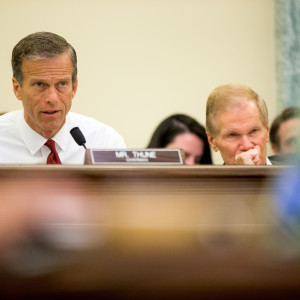A Senate committee moved to advance a bill Thursday designed to free up more spectrum to feed wireless providers’ growing need for airwaves and power high-bandwidth services including video streaming and new technology like 5G.
The Senate Commerce, Science and Transportation Committee finished markup Thursday of the Making Opportunities for Broadband Investment and Limiting Excessive and Needless Obstacles to Wireless (MOBILE NOW) Act, written by Chairman John Thune and ranking Democrat Sen. Bill Nelson with the goal of freeing up 255 megahertz (MHz) of spectrum for wireless providers and unlicensed innovators in the 3.1 gigahertz (GHz) to 3.5 GHz band and the 3.7 GHz to 4.2 GHz band.
“The committee’s advancement of the Mobile Now Act was truly a bipartisan effort,” Thune said after the markup. “Enactment of this legislation will pave the way to a 5G future where Americans have access to ultra-fast, next generation wireless technology.”
MOBILE NOW, originally scheduled for markup last fall, gives the National Telecommunications and Information Administration inside the Commerce Department 18 months to come up with ways to incentivize federal agencies to consolidate, share and surrender spectrum, 60 percent of which is held by the government.
The bill will also make it easier to build wireless towers on federal land — a designation that covers 1/3 of all national real estate — speed up the approval process of building new facilities and combine laying new wireline with federal highway construction projects.
Senators further tacked on a manager’s amendment with 12 additional bi-partisan amendments.
One supported by Sens. Brian Schatz, Jerry Moran, Cory Booker, Cory Gardner and gig-economy advocate and 2016 GOP presidential hopeful Sen. Marco Rubio sets aside at least 100 MHz of spectrum for unlicensed use — a designation Thune and Federal Communications Commissioner Jessica Rosenworcel recently agreed is crucial to future tech advances in WiFi, the Internet of Things and 5G.
Another 100 MHz would go to commercial mobile providers, some of whom are in danger of running out of airwaves in the next five years, according to FCC Chairman Tom Wheeler.
Additional amendments would commission a report on the availability of public WiFi hotspots in low-income neighborhoods, a plan from the FCC and NTIA to ensure adequate spectrum for unlicensed use and a contest with a $5 million reward for the first new method of increasing spectrum efficiency.
“Americans depend on spectrum to power so many of the devices — including smartphones, tablets and even drones — they use every day,” CEO of the Consumer Technology Association Gary Shapiro said following Thursday’s markup. “With demand for connected devices continuing to skyrocket, we need more spectrum to keep Americans from literally losing signal.”
“The MOBILE NOW Act will help ensure the future of wireless connectivity by securing large swaths of additional spectrum for commercial use by 2020,” said Shaprio, whose group includes AT&T, Verizon and T-Mobile. “This will be critical to the success of future innovations including the rollout of 5G technology.”
Tech, wireless and digital rights groups including Public Knowledge, New America Foundation’s Open Technology Institute and CTIA all applauded the bill’s advancement.
“Today’s vote is a key moment illustrating the overwhelming consensus that unlicensed spectrum has become a critical driver of innovation and economic growth in the United States, and democratizes access to the public airwaves,” government affairs counsel for Public Knowledge Phillip Berenbroick said in a statement.
Though an important step forward, the government still has more to do in incentivizing the deployment of future technologies like 5G, according to former Clinton administration Under Secretary of Commerce Ev Ehrlich.
“[D]espite this positive step forward, there is still much to be done to propel us into our 5G-future,” Ehrlich said Thursday.
The former Commerce Department official said increasing airwaves availability and the subsequent expansion of broadband is key to increasing healthcare and education access and keeping up with consumer demand.
“With consumer demand for wireless resources on the rise, there is an unquestionable need to further refine our spectrum policy in order to accommodate fifth-generation networks,” Ehrlich continued. “Under 5G, we will undoubtedly see a flurry of new Internet-enabled technologies and devices that will require a faster, stronger and denser wireless network, and a sounder infrastructure policy to enable that network.”

